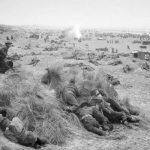Dunkirk
 One method to revise history is by omission. Take the hugely successful movie, “Dunkirk;” writer-director Christopher Nolan’s engrossing version of the last-minute evacuation of 330,000 allied troops, mostly British, surrounded and trapped by Nazi Panzer troops on a wisp of beach at the very northwest tip of France. Across the English Channel lies safety, 26 sea miles away. How to get there? Well, that’s the part of the story of World War II that revisionist Nolan decided to tell. In its first weekend of release, July 21 – 23, the film grossed $50,513,000 on 3,720 screens in the U.S.; $100-million in the first full week. Audiences love what Nolan calls, “a universal story … about communal heroism.” True enough, and he tells a wonderful story.
One method to revise history is by omission. Take the hugely successful movie, “Dunkirk;” writer-director Christopher Nolan’s engrossing version of the last-minute evacuation of 330,000 allied troops, mostly British, surrounded and trapped by Nazi Panzer troops on a wisp of beach at the very northwest tip of France. Across the English Channel lies safety, 26 sea miles away. How to get there? Well, that’s the part of the story of World War II that revisionist Nolan decided to tell. In its first weekend of release, July 21 – 23, the film grossed $50,513,000 on 3,720 screens in the U.S.; $100-million in the first full week. Audiences love what Nolan calls, “a universal story … about communal heroism.” True enough, and he tells a wonderful story.
But wait, how did the British Expeditionary Force get in such a desperate predicament in the first place? That’s the part of history that Nolan apparently feels it is okay to leave out – the part about Adolph Hitler’s hitherto unstoppable Nazi war machine and its relentless march across most of Europe beginning in the autumn of 1939. The part about World War II, for God’s sake! By May of 1940 the Brits, along with most of the French and Belgian armies, and a few Polish and Dutch troops were pushed almost into the sea by the advancing armies of Generals Gunther von Klug and Gerd von Rundstedt. But then, in perhaps the greatest military mulligan of World War II, the Germans (never once mentioned by name in the movie) stopped cold.
On May 24, 1940, Hitler visited General von Runstedt’s headquarters at Charleville and agreed to halt the German advance for three days to give his tired Wehrmacht troops time to re-group and re-supply. Luftwaffe commander Hermann Goering asked for the opportunity to wipe out the allied forces from the air, Hitler agreed, but bad weather kept German planes out of the sky for long periods. This provided just enough time for the allies to organize a desperate flotilla of nearly a thousand civilian and military ships to evacuate the troops. British Prime Minister Winston Churchill had been in office for only two weeks when he delivered one of his most inspiring speeches ever. But, do we hear the speech? No. A line or two from the speech? Ah, no. Is Winston Churchill ever even mentioned? Not until the end of the film – some kid reads a few lines from a newspaper article. Does Nolan give his audience even the slightest hint of historical and political context? No. Some sort of frame of reference to understand why these stranded, exhausted, encircled troops absolutely had to be rescued? No. Are we helped to understand that if Operation Dynamo, as it was called, had failed, the Second World War would quite possibly have been lost before it ever really began? – and we’d be about seventy-five years into a thousand year Third Reich? Does Nolan explain who the “enemy” really was? No. At the beginning of his film, he scrolls a line across the screen announcing the situation: “The enemy has surrounded allied forces, blah, blah . . .” The “enemy?” Even the most politically correct mouthpiece for revisionism is able to spit out the name of Adolph Hitler and the Nazi German war machine once in a while.
How many German soldiers do we see in the film? Zero. Actual ground combat? None. Yes, the aerial dog fights were incredibly well videographed and might win an Oscar, but even so, we have little sense of the who and why. The Nazi iron cross insignia on a Messerschmitt Bf 109 was seen one time, at a distance.
And try as he might, Nolan really leaves the audience with little sense of desperate scale of the catastrophe. Vast beaches filled with desperate soldiers? Nope. We see vast beaches strewn with clumps of a few soldiers . The British generals hoped to rescue perhaps 50,000. Amazingly, in the end, 220,000 British and 120,000 French troops were taken off the beach right under the nose of the powerful Wehrmacht. Some say it was Hitler’s biggest mistake of the war. Everyone agrees it was England’s most heroic stroke of the war.
Still, it took months to resupply the British Army. Operation Dynamo got a lot of young men home to fight again, but they left enough equipment to supply ten divisions – huge caches of ammunition, 880 field guns, 850 anti-tank guns, 700 tanks, 45,000 cars and trucks, 11,000 machine guns.
Christopher Nolan’s “Dunkirk” is compelling, often a feast for the eyes, yet there is no real connection with the characters, nothing about the girl back home or the unquenchable despair of boat owner Mr. Dawson over the loss of his aviator son, or why so many blunders led to the calamity at Dunkirk. Christopher Nolan wrote and directed a fine film that will earn untold millions and a boatload of awards, but I say his narrative could have been greatly improved by letting someone like Edward R. Murrow take a crack at the script.
Listen to Murrow’s reporting on the Dunkirk evacuation:
